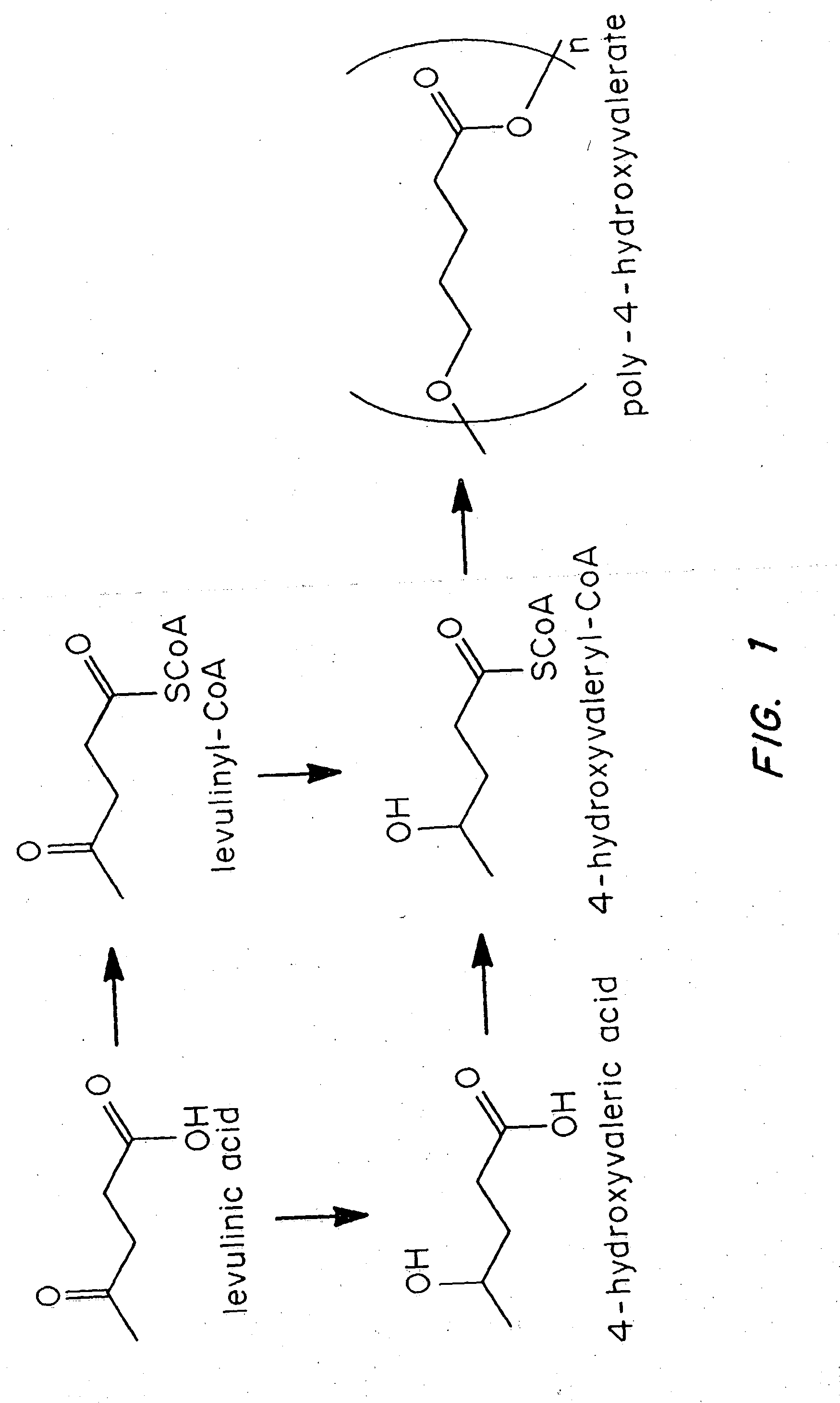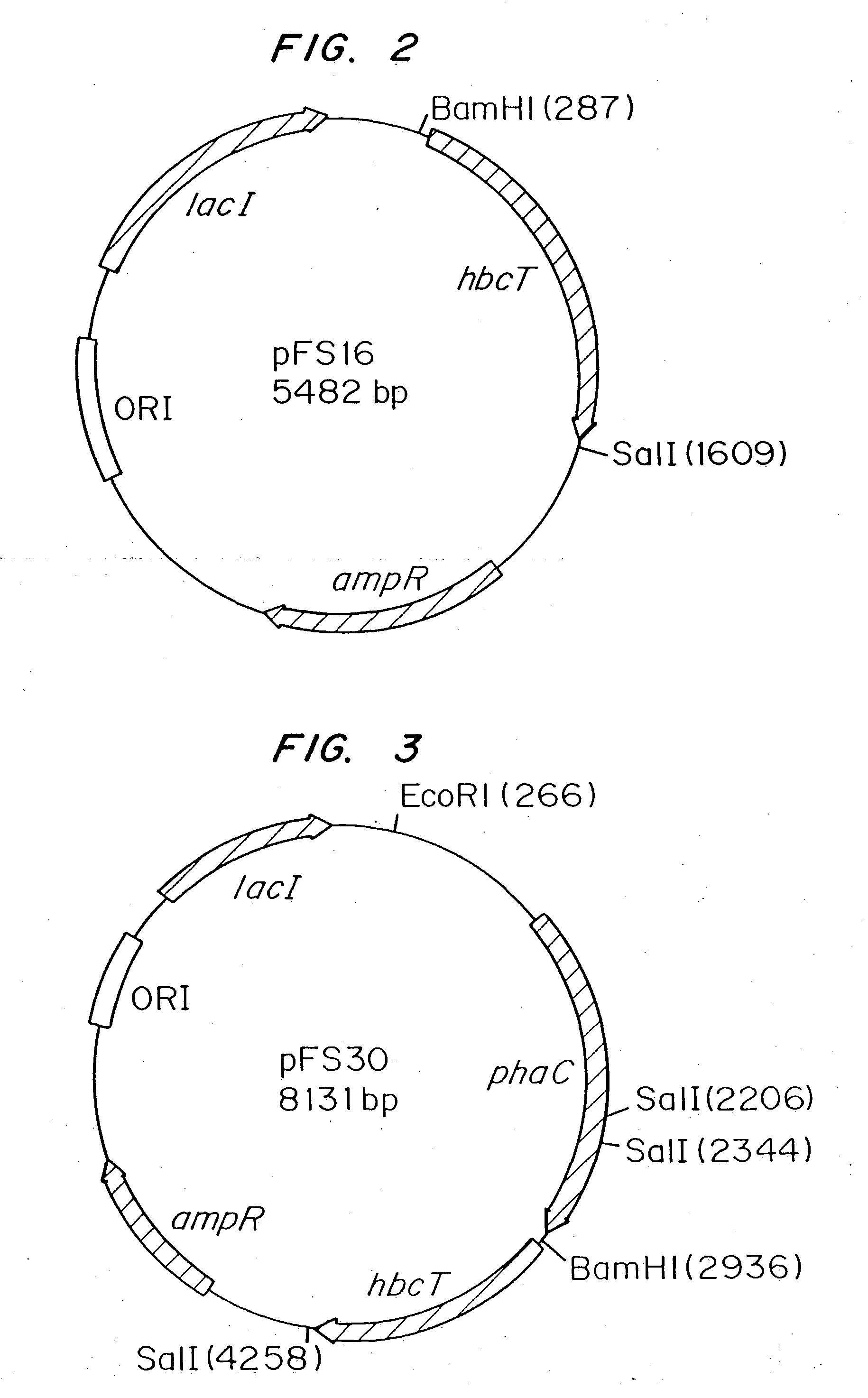Polyhydroxyalkanoate biopolymer compositions
a technology of polyhydroxyalkanoate and composition, applied in the direction of enzymology, ligases, transferases, etc., can solve the problems of loss of product, limited commercial availability of phas, and unsatisfactory plasmid-based systems
- Summary
- Abstract
- Description
- Claims
- Application Information
AI Technical Summary
Benefits of technology
Problems solved by technology
Method used
Image
Examples
example 2
Poly(4HV) from 4-hydroxyvalerate in E. coli
[0029] Escherichia coli MBX1177 is not capable of synthesizing poly(3-hydroxybutyrate) (PHB) from glucose. MBX1177 is a spontaneous mutant of strain DH5.quadrature. that is able to use 4-hydroxybutyric acid as a carbon source. MBX1177 carrying the plasmid pFS30 (FIG. 2), which permitted the expression of the Clostridium kluyveri 4HB-CoA transferase and the Ralstonia eutropha PHA synthase, was precultured at 37.degree. C. in 100 mL of LB medium containing 100 .mu.g / mL sodium ampicillin.
[0030] The cells were centrifuged at 5000 g for 10 minutes to remove them from the LB medium after 16 hours, and they were resuspended in 100 mL of a medium containing, per liter: 5 g sodium 4-hydroxyvalerate (4HV); 2 g glucose; 2.5 g LB broth powder; 100 mmol potassium phosphate, pH 7; 100 .mu.g / mL sodium ampicillin, and 0.1 mmol IPTG. The cells were incubated in this medium for 3 days with shaking at 200 rpm at 30.degree. C. in the same flask in which they h...
example 3
Poly(3HB-co-2HB) from 2-hydroxybutyrate and Glucose in E. coli
[0032] E. coil MBX769 carrying the plasmid pFS16 was precultured at 37.degree. C. in 100 mL of LB medium containing 100 .mu.g / mL sodium ampicillin in a 250-mL Erlenmeyer flask with shaking at 200 rpm. The cells were centrifuged at 5000 g for 10 minutes to remove them from the LB medium after 16 hours, and they were resuspended in 100 mL of a medium containing, per liter: 5 g sodium 2-hydroxybutyrate (2HB); 2 g glucose; 2.5 g LB broth powder; 50 mmol potassium phosphate, pH 7; 100 .mu.g / mL sodium ampicillin; and 0.1 mmol IPTG. The cells were incubated in this medium for 3 days with shaking at 150 rpm at 33.degree. C. in the same flask in which they had been precultured. The cells accumulated a polymer to 19.0% of the dry cell weight that consisted of 99.7% 3HB units and 0.3% 2HB units. The identity of the poly(3HB-co-2HB) polymer was verified by GC analysis of the solid product obtained by chloroform extraction of whole ce...
example 4
Poly(2HB) from 2-hydroxybutyrate in E. coli
[0033] Escherichia coli MBX184 is not capable of synthesizing poly(3-hydroxybutyrate) (PHB) from glucose. MBX184 is deficient in fadR and expresses atoC constitutively.
[0034] MBX184 carrying the plasmid pFS30 was precultured at 37.degree. C. in 100 mL of LB medium containing 100 .mu.g / mL sodium ampicillin. The cells were centrifuged at 5000 g for 10 minutes to remove them from the LB medium after 16 hours, and they were resuspended in 100 mL of a medium containing, per liter: 5 g sodium 2-hydroxybutyrate (2HB); 2 g glucose, 2.5 g LB broth powder, 50 mmol potassium phosphate, pH 7; 100 .mu.g / mL sodium ampicillin; and 0.1 mmol IPTG. The cells were incubated in this medium for 3 days with shaking at 150 rpm at 33.degree. C. in the same flask in which they had been precultured.
[0035] The cells accumulated a polymer to 1.0% of the dry cell weight that consisted of 100% 2HB units. The identity of the poly(2HB) polymer was verified by GC analysis ...
PUM
| Property | Measurement | Unit |
|---|---|---|
| flow rate | aaaaa | aaaaa |
| temperature | aaaaa | aaaaa |
| pH | aaaaa | aaaaa |
Abstract
Description
Claims
Application Information
 Login to View More
Login to View More - R&D
- Intellectual Property
- Life Sciences
- Materials
- Tech Scout
- Unparalleled Data Quality
- Higher Quality Content
- 60% Fewer Hallucinations
Browse by: Latest US Patents, China's latest patents, Technical Efficacy Thesaurus, Application Domain, Technology Topic, Popular Technical Reports.
© 2025 PatSnap. All rights reserved.Legal|Privacy policy|Modern Slavery Act Transparency Statement|Sitemap|About US| Contact US: help@patsnap.com


